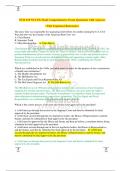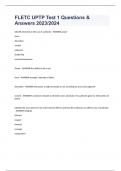NUR 410 NCLEX Final Comprehensive Exam Questions with Answers
(With Explained Rationales)
The nurse who was responsible for organizing relief efforts for soldiers during the U.S. Civil
War and who was the founder of the American Red Cross was
A. Clara Barton.
B. Sojourner Truth.
C. Mary Breckenridge. - A. Clara Barton
Clara Barton was responsible for organizing relief efforts during the U.S. Civil War. In 1882, she
successfully persuaded Congress to ratify the Treaty of Geneva, which allowed the Red Cross to
perform humanitarian efforts in times of peace. Lavinia Dock was a writer and political activist.
Sojourner Truth was an advocate for abolishing slavery and supporting women's rights. Mary
Breckenridge developed nursing in rural Kentucky in the 1920s, establishing the Frontier
Nursing Service.
Which act, established in the 1940s, provided grants to states for the purpose of new construction
of health care institutions?
A. The Health Amendments Act
B. The Hill-Burton Act
C. The Tax Equity and Fiscal Responsibility Act
D. The McCarren-Ferguson Act - B. The Hill-Burton Act
The Hill-Burton Act of 1946 provided grants to states for the construction of new hospitals,
targeting low income and rural areas. The McCarren-Ferguson Act gave states the right to
regulate health insurance plans. The Health Amendments Act authorizes funds for registered
nurse education in administration, supervision, or teaching. The Tax Equity and Fiscal
Responsibility Act established the prospective payment system for
Which is the correct process a bill must take before final approval by the president?
a. A bill must go through discussion by the Supreme Court and then be submitted for final
approval by the president.
b. A bill must succeed through the two legislative bodies, the House of Representatives and the
Senate, and then be submitted for final approval by the president.
c. A bill must be approved by the House and Senate and then go before a committee before being
submitted for final approval by the president.
d. A bill must succeed through one of the two legislative bodies, the House of Representatives
and the Senate, and then be submitted for final approval by the president. - D. A bill must
succeed through the two legislative bodies, the House of Representatives and the Senate, and
then be submitted for final approval by the president.
a. A bill must go through discussion by the Supreme Court and then be submitted for final
approval by the president.
,b. A bill must succeed through the two legislative bodies, the House of Representatives and the
Senate, and then be submitted for final approval by the president.
1. The bill must succeed through both legislative bodies, the House of Representatives and the
Senate. The Supreme Court is not involved in creating legislation. A bill goes before a
committee before going to either legislative body.
c. A bill must be approved by the House and Senate and then go before a committee before being
submitted for final approval by the president.
d. A bill must succeed through one of the two legislative bodies, the House of Representatives
and the Senate, and then be submitted for final approval by the president.
Decisions on public policy are made by which part of the federal government?
1. Legislative, executive, or judicial branches of the government
2. Only the executive branch (president, governor, mayor)
3. Supreme Court
4. House of Representatives and Senate - 1. Legislative, executive, or judicial branches of the
government
Public policy refers to decisions made by legislative, executive, or judicial branches at the local,
state, or federal levels of government.
A statement of a decision regarding a goal in health care and a plan for achieving that goal is
called
A. nursing policy.
B. fiscal policy.
C. social policy.
D. health policy. - D. health policy
Health policy is a statement of a decision regarding a goal in health care and a plan for achieving
that goal. Nursing policy specifies nursing leadership that influences and shapes health policy
and nursing practice. Fiscal policy is related to finance. Social policy is policy associated with
individuals and communities.
Groups such as professional organizations, nonprofit health care organizations, and corporations
that sponsor health care are/is called
A. the public sector.
B. the private sector.
C. stakeholders.
D. field experts. - the private sector.
The private sector includes employers, professional organizations (e.g., American Hospital
Association), nonprofit health care organizations (e.g., American Heart Association), and for-
profit corporations that deliver, insure, or fund health care services outside government control.
The public sector is concerned with providing government services. A stakeholder is one who
can affect or be affected by the actions of an organization as a whole. An expert is one who has
extensive knowledge or skill in a particular field.
, The Health Resources and Services Administration (HRSA) assists nursing workforce
development by
A. establishing schools of nursing.
B. supporting organizations with a political agenda for health care.
C. providing federal funds to promote health care reform.
providing grants to provide for education and recruitment. - providing grants to provide for
education and recruitment.
The nursing workforce development programs administered by the HRSA through Title VIII
provide federal support for nurses' workforce development. The HRSA does not establish
nursing schools but provides federal funding for nursing education at the undergraduate and
graduate levels and favors institutions that educate nurses for practice in rural and medically
underserved communities. The other options do not assist nursing workforce development.
A person who acts as a representative for another person or organization before the legislature is
called a(n)
A. advocate.
B. policy maker.
C. lobbyist.
D. field expert. - C. lobbyist
A lobbyist is a person, who voluntarily or for a fee, represents him- or herself, or another
individual, organization, or entity for the purpose of influencing policy or legislation. An
advocate is a person who supports a cause or policy. A policy maker is one who creates policies.
An expert is one who has extensive knowledge or skill in a particular field.
Political action committees (PAC) are formed by professional organizations, business, or labor
groups for the purpose of
A. attracting candidates who are sympathetic to particular health care issues.
B. lobbying legislation about health policies.
C. being an advocate for health care reform.
D. providing financing to professional organizations. - attracting candidates who are sympathetic
to particular health care issues.
PACs are nonpartisan entities that promote the election of candidates believed to be sympathetic
to their interests. The purpose of specific PACs could be to promote certain health care issues or
health care reform or to obtain financing for certain professional organizations.
Nurses' involvement in policy can be achieved by (Select all that apply.)
A. conducting and supporting health policy research.
B. avoiding discussions that involve health policy that may be controversial.
C. working with health care professionals to influence change in the quality of health care.
D. writing letters to educate legislators about health care issues.





